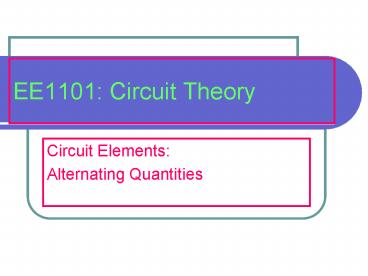EE1101: Circuit Theory - PowerPoint PPT Presentation
1 / 25
Title:
EE1101: Circuit Theory
Description:
Volt-Ampere Relationships. Basic: Assume V & I are d. c. values. ... Volt-Ampere Relationships. Time-varying: ... Volt-Ampere Relationships ... – PowerPoint PPT presentation
Number of Views:37
Avg rating:3.0/5.0
Title: EE1101: Circuit Theory
1
EE1101 Circuit Theory
- Circuit Elements
- Alternating Quantities
2
Circuit Elements R, L, C
- R, L C are the basic circuit elements.
- Each one has special properties (physical
elements) and behaves differently when subjected
to an electrical signal. E.g. if a d. c. source
is connected R will dissipate heat, L will be a
short-circuit C will be an open circuit.
3
R, L, C (cont.)
- Used alone or better in conjunction with others
to have a desired circuit behaviour - When connected together in series or parallel and
subjected to various sources e.g. d. c. or a. c.
with varying frequency, the responses are of
engineering interests as will be evident in a. c.
circuit analyses.
4
R, L, C (cont.)
- It is best to define the impedances of R, L C
as complex expressions. - Impedance of R R j0
- Impedance of L 0 jwL
- Impedance of C 0- j/wC
5
R, L, C circuits Series R-L circuit
- Series R-L Circuit
R
i
V
Vsin(wt)
L
-
6
R, L, C circuits Parallel- Series circuit
- Parallel-Series Circuit
i
L
R
Isin(wt)
C
7
R, L, C circuits Parallel- Series circuit
- Exercises
- 1. Determine the expressions for the currents in
the circuits above. - 2. Determine the expressions for the different
impedances total impedance. - 3.Find arg.Z mod.Z
- 4.Assume a source of varying freq (w) sketch
arg.Z vs. w indicate critical pts.
8
R, L, C circuits Parallel- Series circuit
- 5. Assume the source to be the reference phasor
determine the expressions for the various
voltages currents. - 6.Sketch the currents voltages vs. w indicate
all the critical points.
9
Volt-Ampere Relationships
- Basic Assume V I are d. c. values. Hence have
no phase difference i.e. V is in phase with I. - Hence
- Power VI (Watts)
- Resistance V/I (Ohms)
- Conductance I/V (mohs)
10
Volt-Ampere Relationships
- Time-varying
- We have so far assumed that the magnitude (phase
frequency) of any given current or voltage is
constant. - In some cases this may not be true either by
design or due to some influence. - However, the basic laws still apply.
11
Volt-Ampere Relationships
- Either the magnitude, freq or phase may change
with time (in our case predictably). - Consider V I given by
- v V(t)sin(w(t))
- i Isin(w(t))
- Clearly, V w as well as v i vary with time.
12
Sine wave is a Periodic Function
- But, unless stated otherwise, we always assume
that V w are constant. So that - v Vsin(wt).
- Or
- v(t) Vsin(wt)
- where
- V peak value.
13
Sine wave is a Periodic Function
V
v Vsin(wt)
T
PeriodT Frequencyw
14
Periodic Functions
- It is noted that even if v w were constant V
I would be variable. - But in this case there would certain predictions
of the values at any time. - It is also true that the shapes of V I repeat
themselves after _at_ given time known as the
period. Hence V I are called periodic functions.
15
Periodic Functions
- v Vsin(wt)
- i Isin(wt)
- These are called sinusoidal functions with period
(T). - w 2pf
- Where f is the frequency.
- N.B. f 1/T
16
Average RMS Values
- It is important to understand average values and
Root Mean Square (RMS) values because they form
the basis of power in electrical engineering. - Clearly, the average values of a.c. signals are
ZERO! We can easily show this by integrating v
i over a full period.
17
Average RMS Values
- The average values of v I are
- v Vsin(wt)
- i Isin(wt)
18
Average RMS Values
- This would worry us because it may seem that a.c.
currents are useless when passed through a
resistor. - But practice shows that when an a.c. current
passes through a resistor it dissipates energy in
the form of heat. - So we use power to understand the effects of a.c.
signals.
19
Power Dissipated in Resistor, R
- We know that power dissipated in a resistor is
given by - The plot of P is
P
wt
20
Power Dissipated in Resistor, R
- The plot of P clearly shows that it is always
positive hence its average value is positive.
an assurance that P causes heat/energy to be
dissipated in R. - Let us confirm mathematically
21
Power Dissipated in Resistor, R
- Consider the power dissipated in resistor R when
the source is a.c. or d.c. Assume that the same
power is dissipated.
i
I
d.c.
a.c.
R
r
r
R
22
Average RMS Values
- The average power dissipated in R is given by
23
Average RMS Values
- Hence it is clear d.c. current which will
dissipate equal power to R equals square root of
the mean of the squares of the a.c. current.
Hence the name Root of the Mean of Squares or
RMS. - Exercise If the a.c. current is given by
- iIsin(wt) find the relationship between the
d.c. and a.c. currents.
24
Average RMS Values
- Solution
25
Average RMS Values
I
d.c. equivalent value
0.707 I
iIsin(wt)
-I































